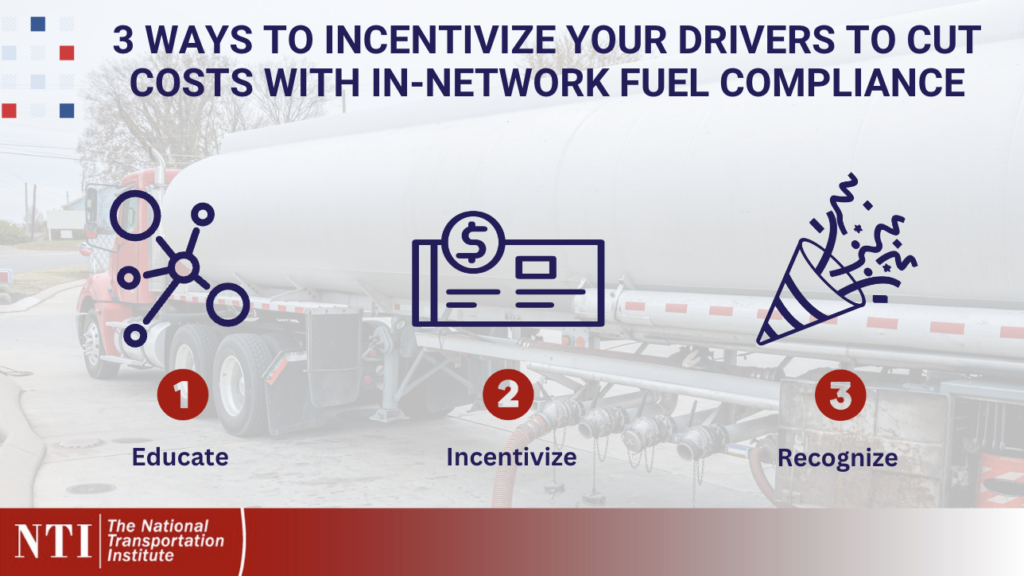Even though the price of on-highway diesel has fallen by nearly $2 a gallon since the spring of 2022, the price is still hovering around $4 a gallon and accounts for one of the largest expenses in fleet operations.
Also, in the current sluggish freight market, per-mile rates both on the spot market and in the contract market have stumbled and remain slack, adding to the urgency for fleets to find opportunities to trim costs, enabling ways to help boost their profitability.
There are plenty of variables outside of fleets’ control and drivers’ control in today’s environment. But one element squarely in control is in-network fuel compliance, which can save hundreds of thousands, if not millions, of dollars annually. Those savings often can go directly to the bottom line.
➡️ Looking for more driver pay strategies to help promote fleet profitability in the current freight environment? Read NTI’s 6 Driver Pay Strategies to Excel in a Slower Freight Market. ⬅️
U.S. Bank works with fleets large and small to provide fuel purchasing controls and monitoring tools using its Voyager fleet program. The bank says savings typically range at 3% or more for fleets who effectively manage in-network fueling compliance. For example, U.S. Bank cited two fleet customers who’ve saved $700,000 and $1 million annually after implementing better reporting, auditing, and compliance protocols.
For example, drivers at those fleets shared they “simply did not know that purchasing premium fuel was outside of their fleet’s proper procedures,” said Cheryl Garcia, Senior Vice President at U.S. Bank Transportation Solutions.
Tying fuel network compliance and cost savings to driver pay is a critical area where fleets can engage with their drivers, use internal marketing programs to communicate with drivers, and provide an opportunity for drivers to take home more money without increasing payroll expenses.
Here are a few ways fleets can work with their drivers on this topic:
➡️ First, simply educate your drivers on network compliance and remind them to fuel where asked.
After all, that’s part of their job. And as the notes from U.S. Bank point out, drivers would likely be happy to ensure they’re fueling at the right locations had they been aware. “Fleets need to have the confidence and security to have these conversations with drivers,” says Leah Shaver, president and CEO of NTI. “Communicating with drivers in turbulent times is something you should be excited to do. Make sure you and your team are well versed in the programs that help individual drivers and that support the company as a whole. Narrow your focus to what you can control — what drivers can control, and what your company can control.”
In addition to phone calls and in-person conversations, use your arsenal of internal marketing tools to reach drivers on this issue: email newsletters, social media posts, text messages — any communication tool that drivers use and where you know you can reach them and the message will be heard. Be specific about the opportunities and value that fuel network compliance can have and about the actions that drivers can take personally to achieve those company goals.
U.S. Bank also recommends engaging with drivers to shape these policies. In addition to implementing technology and reporting tools, “successful programs are collaborative,” Garcia says.
➡️ Secondly, incentivize it in the paycheck. Here’s how:
Many fleets offer a cent-per-mile add-on for drivers who hit miles-per-gallon targets. According to survey data from The National Transportation Institute’s National Survey of Driver Wages, fuel efficiency bonuses range from a cent to over 4 cents.
Do the same thing with compliance pay. Consider adding a penny per mile or more for drivers who reach the network compliance goal you’re seeking. Since your fuel cost savings will be much greater than that, it’s a win-win financial situation for both your company and your drivers. Also, with productivity incentives harder to reach for drivers in today’s market, the cost to your fleet to incentivize fuel network compliance will be minimal.
While some companies may strive for a very high percentage, such as 90 or 100%, every fleet’s goal will be different based on their current situation. For example, says Garcia, an 80% goal might be right for some, or an incremental goal each period (usually quarterly or annually) and then measure progress.
In their work with fleets on this issue, financial rewards “have an immediate and lasting impact,” said U.S. Bank, and those rewards “increase driver satisfaction, engagement, and retention.”
“With the right approach, [drivers] will connect personally to the fleet’s financial success.”
➡️ Don’t forget your contractors
Contractors love freedom to choose – and we love that for and about them – but now is an ideal time to remind them why they chose you, what they liked about you, and why they should continue to stay. Your negotiated in-network savings can and should be a continued hook to remain strong partners. Make sure your fuel manager and lease manager are working together to identify opportunities to extend this offering and more to your contractors.
➡️ Lastly, celebrate drivers’ success with recognition programs and retention.
When drivers do achieve the goals you set, promote their success on social media, in company newsletters, in one-on-one conversations, at company meetings, with wraps on trucks and trailers, and any other opportunities you can. Rely on feedback and recognition “to help drivers feel more vested in their careers and their fleet’s success,” says U.S. Bank.


